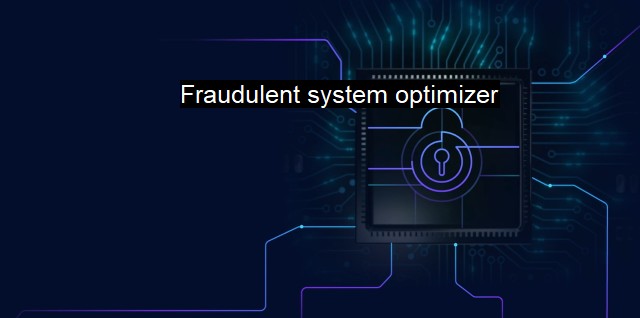What is Fraudulent system optimizer?
The Tricks Fraudulent System Optimizers Play: Understanding and Securing Against Cybersecurity Vulnerabilities in a Digital Society
A fraudulent system optimizer is a type of malicious software (malware) that masquerades itself as a useful tool designed to improve or optimize a computer's performance. They present themselves as beneficial programs providing services such as disk cleaning, system error debugging, and virus scanning. Their actual purpose is quite different: they aim to deceive users into paying for a service they do not provide while potentially compromising the integrity of their systems.The process usually begins with the fraudulent system optimizer pop-up that alerts users of detected issues, such as severe virus infections, critical hard-drive errors, and excessive system clutter. These alerts are meant to scare the user, persuading them to take immediate action, which generally involves purchasing the full version of the application for error rectification.
This whole process is nothing short of an elaborate scam that preys on users' lack of technical expertise and exploits their anxieties about keeping their computers safe. It becomes a form of scareware, instilling fear and urgency for the user to proceed with a solution the software falsely offers.
Interestingly, what makes fraudulent system optimizers quite dangerous is that they often behave like legitimate applications. They often feature professionally designed logos, icons, and user interfaces to boost the illusion of authenticity.
Ironically, while such programs promise to improve your computer's health, they can dramatically affect the performance and stability of the system. They are not only ineffective at cleaning and speeding up your computer; they often leave harmful files and damage existing operating system files, consequently putting one's cybersecurity at risk.
This fraudulent software not only targets the user's wallet but may also open backdoors for other malware to infiltrate the system, increasing the exposure of the user's sensitive data. Common ensuing issues include ID theft, password theft and unauthorized access to personal files or even financial accounts.
Some fraudulent system optimizers do more than just damage your software. They may 'kidnap' your data via a form of malware called ransomware. they encrypt all your files, making them inaccessible until you pay the fraudsters a hefty fee for the 'decryption key.'
According to cybersecurity and antivirus experts, prevention is always better than cure, especially regarding rogue security software, such as fraudulent system optimizers. This prevention starts with better user education about valid signs of threats and security practices.
Fraudulent system optimizers often distribute through shady distribution milestones like spam email, pop-up ads, and bundled software. Users need to become vigilant while opening any email attachment and downloading any tools from unauthorized websites.
One effective defense against fraudulent system optimizers is using trusted antivirus software that screens all downloads and email attachments for viruses and other threats. Antivirus applications continually update their threat databases for the latest online hazards to detect and block them efficiently and promptly.
Fraudulent system optimizers are deceptively harmful cyberthreats. They embody the logic of disguised wolves, presenting benign surfaces hiding malicious intents underneath. It's critical for every user to recognize these threats and take the necessary precautions to prevent any possible attacks. While some of the best protection against these threats will primarily be early detection and preventive measures such antivirus software, educated and informed navigation through the digital world also goes a long way in thwarting these virtual vandals.
Whether dealing with possible phishing mails or being lured by the promise of 'free' system optimizers, the old adage rings true — it's better to be safe than sorry. Be vigilant, be informed, and always choose validated sources and software to keep your systems and data secure. The domain of cyber threats might seem daunting, but, with the right tools and knowledge, one can navigate through it safely and efficiently.

Fraudulent system optimizer FAQs
What is a fraudulent system optimizer?
A fraudulent system optimizer is a type of malware that disguises itself as a legitimate system optimization tool. It tricks users into paying for its fake services with promises of improving their computer's performance. However, once the payment is made, it does not deliver any optimization benefits and may even harm the computer's security.How does a fraudulent system optimizer infect a computer?
Fraudulent system optimizers can infect a computer through various methods, including phishing emails, malicious downloads, or spam pop-ups. They might also come bundled with free software or be installed by other malware.What are the signs that a computer is infected with a fraudulent system optimizer?
Some of the signs that a computer is infected with a fraudulent system optimizer include constant pop-ups and alerts claiming that the computer is infected, slower than usual performance, and increased CPU usage. The malware may also change the computer's settings or install additional malicious software.How can I protect my computer from fraudulent system optimizers?
You can protect your computer from fraudulent system optimizers by regularly updating your antivirus software and avoiding suspicious downloads or links. Be cautious of free optimization software that claims to improve your computer's performance and always verify the legitimacy of any software before installing it. Additionally, use a reliable ad-blocker, avoid clicking on advertisements, and be wary of unexpected pop-ups.| | A | | | B | | | C | | | D | | | E | | | F | | | G | | | H | | | I | | | J | | | K | | | L | | | M | |
| | N | | | O | | | P | | | Q | | | R | | | S | | | T | | | U | | | V | | | W | | | X | | | Y | | | Z | |
| | 1 | | | 2 | | | 3 | | | 4 | | | 7 | | | 8 | | |||||||